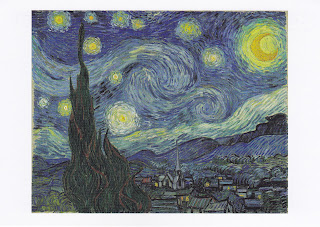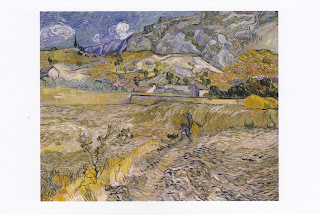One of my postcard series lays out my theory of The Starry Night, which I have sent to numerous people, in varying iterations.
In early December of 2022, I read in the New York Times that the Metropolitan Museum of Art was planning an exhibition of Van Gogh's cypress paintings for spring of 2023. The big news was that the Museum of Modern Art would be lending The Starry Night for the exhibition.
I have been researching The Starry Night in fits and starts for nearly twenty years, with the hopes of writing a book about the fallacy of the expressive theory of art, with my interpretation of this painting as the centerpiece. Gradually it has become apparent to me that the book is never going to happen, but I remain confident in my radical interpretation of The Starry Night. I felt certain that the curator of this new exhibition intended to perpetuate the standard interpretation of the painting, that it is a composite image from Vincent's imagination, and I figured that if I wasn't going to write a book I should at least get my core interpretation of the painting to the curator at the Met. I gave myself a deadline of mid-January and on January 23, 2023, I mailed a 43-page essay to Susan Alyson Stein, Curator of Nineteenth-Century European Painting at the Met and the curator of the upcoming show.
I submitted my essay for inclusion in the catalogue for the show. I knew it wouldn't be used, but I figured, why not shoot for the moon. At the very least, they would get an idea of how important I feel my theory is. A couple of weeks after I mailed the essay, I actually got a call from the Met, from one of Ms. Stein's assistants. I didn't recognize the number, obviously, so I let it go to voicemail:
“Hello, Mr. Hartley. I’m calling from the Metropolitan Museum and I just wanted to let you know that we received your letter about the van Gogh cypresses paintings. We really appreciate you contacting us but as I’m sure you can appreciate the catalogue is already [pause] about to go to print and the curator hasn’t really had much time to consider what you’ve sent. But she will take a look when there is an opportunity. And again we really appreciate your enthusiasm about this subject. So, thanks again for getting in touch; have a good day. Bye!”
A few days after I sent the manuscript, I decided to send Stein a series of postcards summarizing my theory. I hoped that this would pique her interest in reading the essay, or at least give her my theory in a nutshell.
Here are the cards I sent, with transcripts of the texts I wrote on them:
"The first time I threw the Starry Night up on the big screen in the classroom I did a double take, recognizing that the brightest 'star' must be Venus. ¶ Ned Hartley"
"Vincent painted the view from the window of his cell in the asylum at Saint-Rémy 15 times, 16 if you count the Starry Night. ¶ The 3 elements visible in all the paintings are the wheat field in the foreground, the stone wall in the middle ground, and the diagonal slope of the Alpilles in the background. ¶ Ned Hartley"
"This is the first painting Vincent did of the view. It has all the elements—the wheat field, the stone wall, the Alpilles—plus four buildings that will appear in varying numbers in all iterations of the view. ¶ I have dubbed the two central buildings 'asymmetrical' and 'anteroom.' ¶ Ned Hartley"
"This is the second painting Vincent did of the view. In addition to the buildings I have dubbed 'asymmetrical' and 'anteroom,' this one also depicts a lone cypress on the hillock just beyond anteroom. ¶ Ned Hartley""Here's another painting of the view featuring the lone cypress on the hill. ¶ Thanks for the phone call from your assistant! ¶ Ned Hartley"
"The romantic in me likes to think that Vincent identified with this solitary cypress, and the first day he was allowed off the grounds of the asylum he trekked up into the hills to find it and paint it. (When he got there he saw that it was actually two cypresses. nbd) ¶ Ned Hartley"
"Vincent telescoped 'the view' to paint the Starry Night, bringing the cypresses and Venus closer to the picture plane. ¶ In the foreground can be seen 'anteroom', which Vincent surrounded with an imaginary village. ¶ Ned Hartley"
"The blue slope of the Alpilles in the background convinces me that these are the cypresses on the hill. ¶ Ned Hartley"
"I think the next Van Gogh show should be the 15 paintings of 'the view', including this little one in Richmond. ¶ You could call the exhibition 'The View from the Asylum'. ¶ Ned Hartley"
A postcard of the top painting was next, although I did not discuss it in the text, discussing a painting of the view that was once in the private collection of J. Robert Oppenheimer instead. It is impossible to find a postcard of the Oppenheimer painting, so I used this one. I have since learned that the first painting has been de-attributed as a work by Van Gogh. Consequently, this brings the number of paintings of the view down to fourteen, fifteen if you count The Starry Night.
"The star of the show would be Wheat Field w/Rising Sun, formerly in the collection of J. Robert Oppenheimer and still in a private collection. ¶ It would be nice to bring it to light again ¶ Ned Hartley"
This postcard is actually from the 1986 exhibition at the Met where Ronald Pickvance gave the standard interpretation of The Starry Night as a composite. Stein served as an assistant to Pickvance. Mom and I went to this show!
"I hope you have enjoyed this series of postcards. My intention was to give you a sort of abstract of the essay and hopefully pique your interest in reading it. ¶ Best, Ned Hartley"
I make copies of all the postcards I send. Here's an example of one that I sent to the Met:
I have not heard from Ms. Stein. Obviously, she has staked her entire career on the standard interpretation. In the exhibition catalogue for the cypresses show, she unequivocally declares that The Starry Night is "a composite in the fullest sense of the word." I just happen to think she's wrong.
The cool thing is that my postcards are now in the permanent collection of the Metropolitan Museum of Art, if she was smart enough to have saved them.
















No comments:
Post a Comment